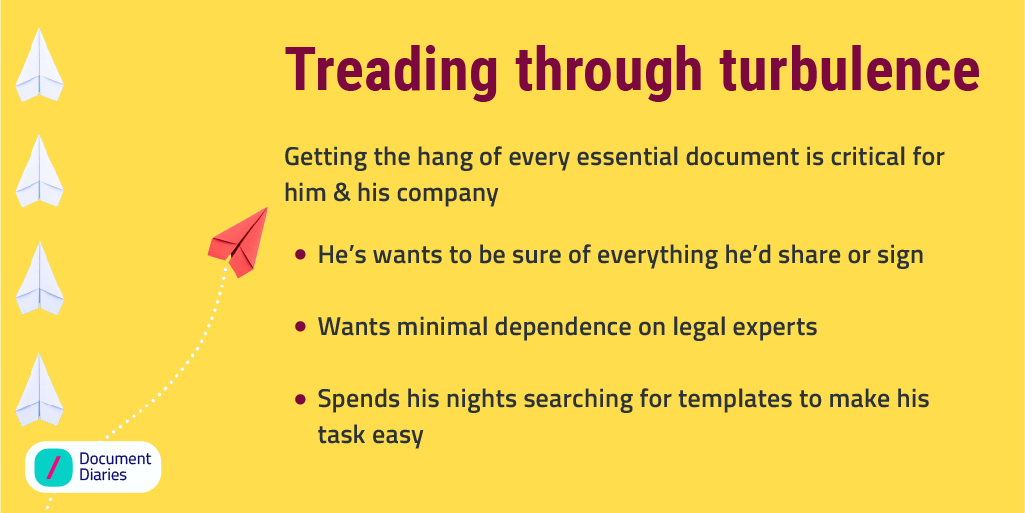Starting a company is exciting and daunting at the same time. You dream of changing the world, and so many things need to come together for it to work. Some hurdles are legal, some operational. Ensuring that legalities are taken care of, and the right operational structure is put in place allows you to focus on your startup’s mission and vision. Based on our experience, here’s a checklist of must-have legal documents for business. With these formalized, you can take the first step to secure your journey as a founder.
What are the essential documents a startup founder needs?
The following are some of the key business requirements documents you would need as a founder to successfully launch a startup.
| Founders’ Agreement |
|---|
| Founders’ agreement is a legally binding contract that outlines the rights, responsibilities, and roles of each owner. As a product of conversations between founders, it protects their interests and prevents conflicts down the line. It could be a single, standalone, or a series of documents, and can be incorporated into corporate bylaws, partnership agreements, or an LLC operating agreement. |
| Why is it essential? • Addresses each owner’s concerns • Clarifies their roles and responsibilities • Provides a dispute-resolution structure for founders • Provides clarity during entry and exit of partners • Protects minority owners • Indicates to investors that you have a serious business |
| Key elements • Ownership structure • Decision-making and dispute resolution • Liabilities and obligations • Confidentiality and non-compete • Representations and warranties • Transfer of ownership • Choice of law |
Any time is a good time to start a company
– Ron Conway, Noted Startup Investor, SV Angel
| Articles of Organization or Articles of Incorporation |
|---|
| To form an LLC, you need to file the Articles of Organization. Similarly, for a corporation, you need Articles of Incorporation (also called a “Charter” in some states). The transferability of shares and liability protection are the defining attributes of corporations and LLC companies. It’s what gives them the status of an independent legal entity under the law. |
| Why is it essential? Only when these documents are completed and filed with the state’s secretary of state’s office, the company comes into existence. |
| Key elements • Company’s formal name & physical address • Brief description of the business • The name and signature of the person who is filing * Note: The company’s original owners need not be identified on the formation document. States like Wyoming and Delaware have enhanced privacy protections for company founders. |
| Operating Agreement |
|---|
| An Operating Agreement is an agreement between the owners of a company. It’s an overview of a company’s functional and financial framework. The document covers the rules, regulations, and provisions that provide the necessary guidance for decision-making. Binding the signatories to its terms, it acts as an official contract. |
| Why is it essential? • Outlines key business aspects (Covers four critical elements of a company: ownership, responsibilities, decision-making, and operating procedures, and is an essential part of the incorporating process. • Protects your liability status (Without it, your company’s structure will resemble a sole proprietorship or partnership, where the responsibility rests with the owner(s)) • Prevents internal conflicts (When the operational conditions and business arrangements are all stated clearly in writing, there’s minimal chance of disagreements) • Legitimize your agreements (Without an official operating agreement, your state’s default rules will govern your company. These rules are generic, vary from state-to-state, and can jeopardize the legitimacy of your contracts) |
| Key elements • Percentage of members’ ownership • Right to vote • Authority levels and responsibilities • Shares in profits and losses • Procedures for transferring interest (Buyout and buy-sell rules) |
| Articles of Association (or just Articles): |
|---|
| Similar to Articles of organization, the Articles of Association are a formation document. While Articles of Organization correspond to an LLC, the Articles of Association create a cooperative association that is identical to partnerships. However, in this setup, the members are autonomous units acting together. For instance, a group of farmers could create a cooperative association and file Articles of Association with the Secretary of State. |
| Why is it essential? The following type of companies must have their own set of Articles of Association: • Unlimited Companies • Companies Limited by Guarantee • Private Companies Limited by Shares |
| Key elements • Purpose of the company • Provisions on the company name • Company’s registration address • Details of founders and original shareholders • Directors, their professional information, and remuneration • Number and type of shares comprising the company’s capital |
| Shareholders Agreement |
|---|
| It outlines the shareholders’ rights and obligations and defines when they can exercise those rights. Many startup founders would seek to draft a Shareholders’ Agreement for the first parties (Founders, Investors, and Shareholders). Through this, they can specify who should be a shareholder. It also includes information on the privileges and protection of shareholders. |
| Why is it essential? The Shareholders’ Agreement includes fair and legitimate pricing of shares. It is designed to ensure the shareholders are treated fairly and that their rights are protected. |
| Key elements • A preamble (It identifies the company and its shareholders) • A list of recitals (rationale and goals for the Agreement) • Details of optional versus mandatory buying-back of shares by the company • The clause for the right of first refusal (Company’s right to purchase or refuse a shareholder’s securities before anyone else) • Notation of a fair price for shares • Description of an insurance policy |
| Article of Amendment |
|---|
| It’s a document filed to effect and formalize changes in the existing Articles of Incorporation and Articles of Association. When a company corporation wants to amend already filed articles, it must provide the following information to the commission, which can be executed through this new document. |
| Why is it essential? The Articles of Amendment, also known as Certificate of Amendment, is to be filed with your state of incorporation. Submitting Articles of Amendment tells the state that the appropriate company representatives have consented to the change. |
| Key elements • Corporation’s legal name and physical address • The text of the amendment(s) adopted • Provision for implementing the amendment, if it doesn’t already exist • Provisions for exchange, reclassification, or cancellation of issued shares • The date of each amendment’s adoption |
| Partnership agreement |
|---|
| It is an agreement between the partners of a company. The document defines the terms and conditions of the relationship between them. Similar to the Operating Agreement, is used by companies having a Partnership structure. |
| Why is it essential? As the partnership agreement spells out the rules and responsibilities for the partners, it ideally ensures the business—and personal—part of the relationship survives. |
| Key elements • Share of ownership • Distribution of profits and losses • Description of management powers • Duties of each partner • Term (length) of the partnership • Details on how to terminate the partnership • Details on how a partner can sell/exchange his share |
| Intellectual Property Assignment Agreement |
|---|
| An IP assignment agreement is paperwork that transfers intellectual property rights from the creator to another entity, such as an acquiring company. Startup founders should have complete ownership of all intellectual property assets in writing during the company’s formation. There are two types of assignment agreements: 1) Technology assignment agreement: This is used to assign the intellectual property from the developer(s) to your startup before you form it. The developer(s) may retain the individual intellectual property rights or sell them for cash or equity. 2) Invention assignment agreement: It assigns the ownership of any relevant intellectual property created by employees to the company. The Agreement typically includes the founder(s) and employees as signatories to a confidentiality and invention assignment agreement. * Intellectual property (IP): Any invention is the result of creativity to which one has rights. It can be protected by applying for a patent, trademark, or copyright and can be prevented from being used without permission. |
| Why is it essential? In the technology business, it is often the value of intellectual property (IP) assets that investors fund or acquirers pay for, which makes this document essential. |
| Key elements • Description and details of the actual assignment • The timing of the assignment • Previously owned IP • Moral Rights • Third-Party Confidentiality/Trust • Warranty Clause • Power of Attorney Clause • Representations and Covenants • Governing Law |
Did you know?
(Source: The United States Patent and Trademark Office)
38.2% of the US’s GDP is comprised of intellectual property.
This adds up to a whopping $6 trillion a year!
| Term sheet |
|---|
| It is the document that lays out the basic terms and conditions under which an investment will be made. The terms of the investment and collateral cover what the startup founder(s) are giving to the investors and getting in return. The document also sets forth the guidelines of how both parties will act to protect the investment and acts as a template to develop more detailed legally binding records. * Note: Term sheets vary depending on various factors. The type of funding round, the size of the stake, and who is involved are vital factors. For instance, the term sheets for seed rounds are much lighter and shorter as compared to series A or beyond. |
| Why is it essential? • Outlines the timetable for negotiation and completion of the transaction • Helps parties negotiate a deal • Helps both founders and investors address misunderstandings or problems at an early stage • Specifies the conditions to be satisfied before getting to the binding documentation • Provides an outline of the process about due diligence |
| Key elements • Founders obligations • Type of collateral • The valuation • Shares and price • The offer amount • Clauses on liquidation or IPO • Voting rights • Conversion options • Anti-dilution provisions • Investors rights to information • Non-disclosure requirements • Rights to future investment • Who will pay legal expenses • Signatures |
| Articles of Dissolution |
|---|
| Dissolution is the voluntary closure of a business and the Article of Dissolution is filed to effect and formalize the closing of an incorporated organization. The document mentions the provisions for the distribution of assets before dissolution. |
| Why is it essential? A corporation is considered dissolved when the Articles of Dissolution come into effect, which doesn’t happen until all the liabilities, fees, penalties, and costs are paid or settled. |
| Key elements • Date of authorization • A statement that the dissolution was duly authorized by an act of the members or board of directors • Effective date • The articles of dissolution |

Take the hard work out of drafting documents. Explore Revv’s template library
Taxation is a crucial aspect for all startups and businesses. Here is a list of the most frequently used tax forms for your reference. The good part is that you can send these forms for an electronic signature too.
Setting up the launchpad
Clark Warner, 35, comes with years of experience in Network Engineering. Having spent a decade in the technology industry, he’s worked out a golden idea. He plans to monetize it by establishing a tech startup. Raising venture capital and issuing stock options is part of his plan.

To position his company for long-term growth and stability from day one, he wants to figure out the essential business requirements document. He’s not too inclined to spend money on legal experts. He’s only looking for insights on these documents that will minimize the uncertainty during his journey as a founder.

Reaching the checkered flag

Having spent sleepless nights on collecting and collating the information on the documents and their key elements, Clark stumbled upon a document management system. It was the goldmine he had been searching for. It provided him with all the essential business requirements document templates that are fully customizable. The content was legally vetted and above all, it was available for free!
The Revv way

With Revv, he could do the following:
- Figure out all the necessary paperwork he was looking for
- Edit the template with the easy-to-use editor
- Share and collaborate much more easily
- Store them all in a centralized repository for future updates
- Save money on lawyers (at least some of it)
Conclusion
Launching a startup is a decision filled with passion. To make the most of opportunities as a startup founder, you must start working on minimizing the uncertainties. Securing a checklist of essential documents is critical to avoid pitfalls in the future. A document management system is what you need to get the vital business requirements document templates in place to fulfill your dream with much more confidence.
Start your document journey with ready-made templates by Revv here. Looking to scale your business? Read the blog to know more about HR-related documents.
Disclaimer: The information presented in this blog post is not intended to be used as legal advice or as a substitute for legal advice. Please contact a legal firm or attorney for a specific purpose.

Simplify your document drafting process. Sign up with Revv


